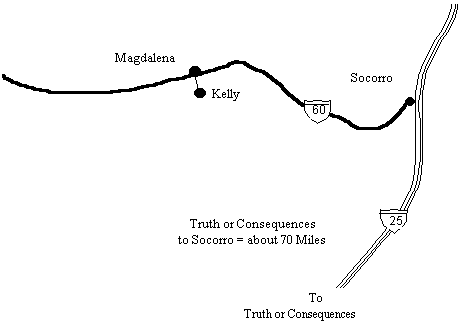Chapter 4 - Ghost Towns and Goldmines
This chapter is on Ghost Towns and Gold Mines. We were intrigued by these and found a few good ones ... and a few that were big on hype but small on interest unless you've got plenty of extra money to spend on souveniers, etc. We also found that there are some good books written on these topics and keyed to a particular state or area ... some comments on these are included.
When I think of the wide open spaces out West, what first comes to mind are ghost towns, gold mines, and dry creekbeds. That's what I was going to call this chapter until I realized that, although I have spent alot of time walking and looking in dry creekbeds, there is little to be said about any particular one. Besides that, I don't really know the names of any that I've explored and don't recall where any particular one is. I have always felt like dry creekbeds must be a good place for finding interesting things like gold nuggets, old coins, and things dropped by people years ago. Although I've walked several miles of dry creekbeds, I guess I've never found anything interesting except rocks. I keep on walking through them whenever I get a chance -- maybe someday I'll find something grand and glorious.
I guess I feel the same way about ghost towns and gold mines as I do about dry creekbeds -- that is, a good place for finding interesting things like gold nuggets, old coins, and things dropped by people years ago. The main difference with the ghost towns and gold mines is that we actually have found some rather intriguing things in them and I can point you to some specific ones that we visited.
One thing we learned somewhere along the line -- in South Dakota, I think -- is that there are two kinds of gold mines: Hard Rock Mines and Placer Mines. A Hard Rock Mine is where they bring in large rocks, then grind them down looking for the gold. A Placer Mine is where they bring in dirt and "pan" for the gold with water (like the old gold miners in the western movies always did it). We visited the largest active Hard Rock Mine in the Western Hemisphere, the Homestake Mine in Lead, South Dakota. For $2 per person, they take you on a very interesting tour of the mine that takes about an hour and a half and teaches you quite alot about gold and mining. For example, we learned that Hard Rock mining is significantly more expensive, but that they get about 4 times more gold (about 1 ounce from 7 tons of rock) than the Placer mines.
Another Hard Rock Mine that we visited was in a ghost town called Mercur, just south of Salt Lake City, Utah. It was a Getty mine and featured a free tour in a van, where they showed you around the outside of things but where you didn't get to see any of the inside workings of the mine. One interesting thing there was that they had dug up an old safe about three months earlier and had not yet opened it to see what was inside. We could not imagine waiting that long to open it -- I wonder what they did find when it was opened. Do you suppose they haven't opened it yet?
The most fun we had at a gold mine was at Wade's Gold Mill in Hill City, South Dakota. We first took a free tour of the gift shop and learned how they make the Black Hills jewelry. Then, we drove out to the mill and took the tour ($5 each) to find out how the gold was processed. They showed us how to pan gold, then let us sit there as long as we liked, getting ore from the same pile as they used to do their processing. We panned for about 5 hours, during which time it rained and we got some very sore muscles. We ended up with five small flakes of gold, probably worth about 50 cents, but had fun getting it. We were told that some people actually set up camp and pan for several days. You'd need to pan a long time to get any significant amount, though, considering that their professional process yields only about 1/4 ounce from 7 tons.
We went through several towns called ghost towns, but most didn't fit the image that we had for a ghost town. When I think of a ghost town, I envision something like what you see in the movies. I would expect a street or two full of standing buildings, including at least a saloon, livery stable, and hotel. They would be delapidated, but still sturdy enough that you could walk around in them. No one would live in the town, except perhaps one or two old hermits who have many interesting yarns to tell if you have the time to listen. Needless to say, we didn't find any exactly like this, but some came close to fitting the description in one way or another. Update: Since then, I've bumped into a couple that came close to this description. If you get time, check out the Old Brayton "ghost town" in Bouse, Arizona or the town of Langtry, Texas. Langtry is not totally a ghost town, but several of the buildings are unoccupied and look like the old West ghost towns visited by James West, John Wayne, and Roy Rogers.
One of the most interesting (and secluded) ghost towns was the town of Kelly about a mile or two south of Magdalena, New Mexico. You won't find Kelly on a map -- just ask at the Post Office. You get to it by taking the road that passes by the Magdalena figure on the side of a cliff -- Joyce saw it, but I never was able to. When we were in Kelly, it was occupied only by some wandering cattle. The only structures in the town were a church, three or four small buildings or parts of buildings, and a mine that we think might have at one time been a zinc mine. One building that we surmised was probably a bank had stone walls and a safe that appeared to have been opened by someone firing hundreds of bullets into the side. There was also an old graveyard where some of the old markers had no dates, just initials. Several had dates from 1900 to 1930 and some as late as the 1980's.
You're Visitor #
 | ||||
Retire and Travel For $1000 a Month

Ghost Town of Kelly, New Mexico
Another fairly interesting "ghost town" was Pinos Altos, near Silver City, New Mexico (shown on the Gila River Campground map earlier). It has a restored opera house and the Buckhorn Saloon, both of which are full of interesting old pictures and artifacts from the days of the old West. Pinos Altos was active in the mid-to-late 1800's and was the closest thing we saw to what we would consider a real ghost town. It actually had standing buildings that you could walk through, but didn't have someone on every corner trying to sell you some souvenirs or arts and crafts.
Let me interject another short but entertaining anecdote at this point. Joyce and I drove into Pinos Altos early in the morning when they were just about to open the saloon and opera house. We asked the lady who was opening it if we could wander through and she said ok, so we were the only ones in the place. I was standing behind the bar and Joyce was sitting on a barstool when she suddenly got a surprised expression on her face and quickly looked around behind herself. She had felt someone walk behind her, but there was no one there. To this day, she is convinced that it was a ghost.
Right after Joyce's ghostly experience, an innocent tourist walked in and sat down behind her without her knowledge. Since she was still somewhat shaken about the ghost, I tried to very calmly tell her that there really was someone behind her now and to not be surprised by him when she turned around. It didn't work. She turned around quickly, saw the man sitting at the table behind her, gasped loudly, and he almost fell out of his chair in surprise. We apologized to him and left soon thereafter. Although we laughed about it later, she was more than a little nervous when it happened. We will always remember Pinos Altos as the most authentic "ghost town" that we have yet seen.
Well, enough chatter about ghost towns and gold mines that we visited. Suffice to say that there are alot of them out there. You can buy books for almost every state west of the Mississippi that will tell you where to find them. We didn't ever buy one of the books though, because #1: we didn't want to spend the money and #2: we prefer to go to places that are "off the beaten track" and not where everyone else goes. It seems like if the places are talked about in a book on the subject, that then there would be alot of people going there. On the other hand, some of the books that we thumbed through also talked about places that you could only get to with a four-wheel drive vehicle. Since we (and probably others) didn't have a four-wheel drive vehicle on our five-month trip, we were unable to go to these places. On our next trip, we will have a smaller vehicle tied on the back of the motorhome for just such occasions.

My First Book
Nothing in this site is copyrighted -- I'd be honored if you'd reuse anything you find here for your website
 | ||||||
